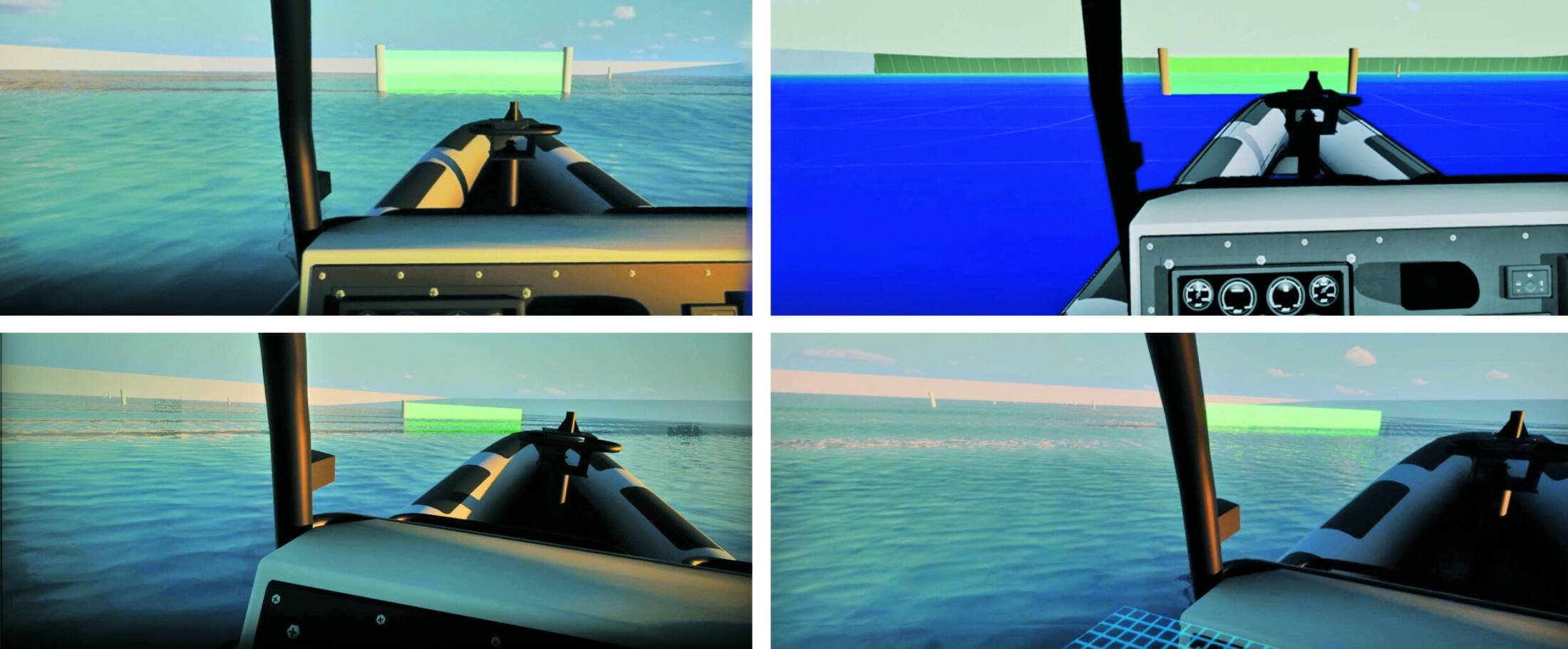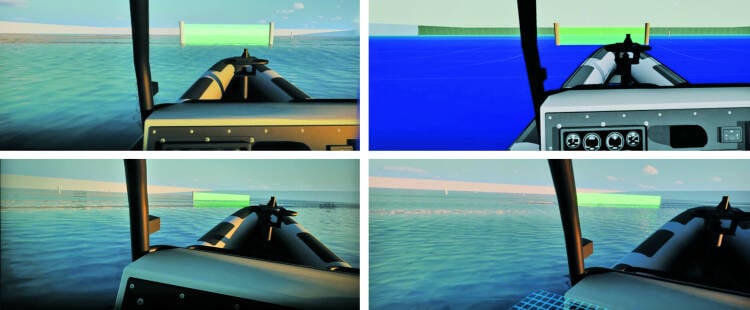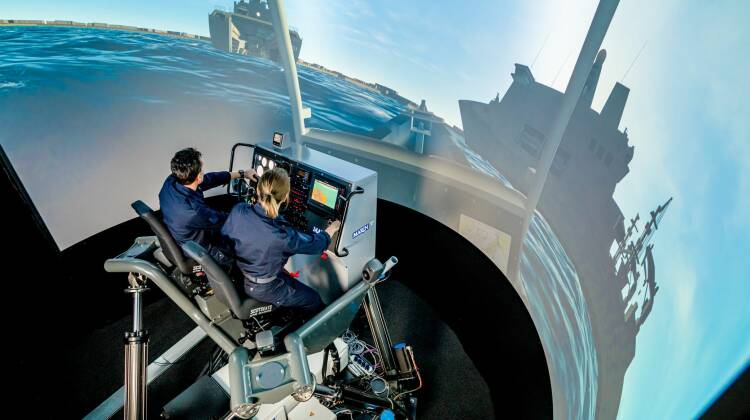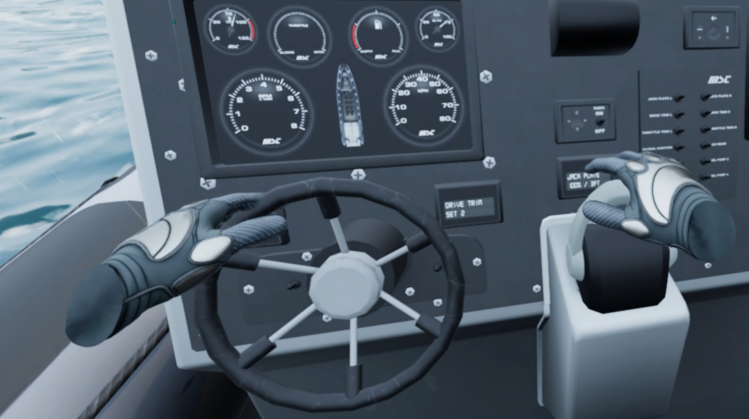www.marin.nl/sosc

More info
June 2024, no. 140
Integrating eXtended Reality at new MX Lab









Interested? Contact us to discuss your options
Create a MARIN account to stay updated


Giorgio Ballestin,
Specialist VR/AR




Figure 1: Experiment: comparison between VR (left) and physical interaction (right) simulations.


Report
A LEVIATHAN amongst simulators
Marking a significant milestone in unlocking new simulation potential within MARIN, the Maritime eXperience Lab (MX Lab) is a cutting-edge facility dedicated to extending MARIN's simulation capabilities through eXtended Reality (XR) technology. The team were so impressed with the potential of the platform they nicknamed it LEVIATHAN (Learning Environment in VR Integrated with Aquatic Technology for Hydrodynamical Navigation).
Virtual reality (VR) stands out as a potent tool for immersive experiences, capable of eliciting psychological and operational responses closely mirroring real-life scenarios. Using VR alongside traditional simulators enables mixed simulations, enhancing MARIN's flexibility in evaluating operations. Concurrently, the growth in automation and advancements in augmented reality (AR) devices point towards an increasing interest in AR solutions within the defence sector, addressing the surge in information overload faced by human operators. However, deploying this technology in the field presents numerous challenges.
Figure 2: Experiment: comparison between various cybersickness compensatory techniques. The first image on the top left shows the control condition without mitigation.

Streamlining XR experience development
MARIN is currently working on a platform to streamline XR experience development, aiming to reduce setup time from days or weeks to a matter of hours. This platform will serve as a potent design tool for early concept evaluation and validation, streamlining the research process. The platform is in the process of being integrated with the Dolphin architecture used by traditional simulators, which will enable the possibility of conducting combined simulations with some of the participants in VR.
Looking ahead, the goal is to enhance the platform's flexibility to simulate even the most complex scenarios. With VR and AR globally gaining significant interest and funding, and technology evolving rapidly, ongoing research efforts are crucial to make the most out of this new technology's potential.
Cable Robot simulator
The Cable Robot simulator has been developed by Fraunhofer IPA and is capable of reaching fast accelerations of about 1.5g. This version is able to move an object within six degrees of freedomand allows for interaction with people. Performance characteristics of cable robots such as speed, payload and workspace can be tailormade for specific applications. Payloads of up to several tonnes per cable are possible due to the outstanding power transmission of the cables. The idea is to deploy this cable robot simulator for multiple use cases such as crew transfers (pilot ladder boarding or basket transfer), replenishment at sea operations, operations on deck, etc.
The second package, Cybersickness, aims to develop explanatory and predictive models concerning XR-related adverse effects like fatigue, eye strain and cybersickness, considering individual characteristics. It also seeks to identify compensatory and mitigating measures to address job performance degradation resulting from these effects (as shown in Figure 2). To measure psychological and behavioural factors within this package, we are going to make use of SHOD (Simulation Human Observation & Debriefing). This is a human factors’ toolbox developed by MARIN that enables simulator data to be aligned with human data, allowing us to make correlations between the behaviour of the human operator and their environment.
The final package, Technology, seeks to forecast anticipated XR developments and their implications for current and future defence XR applications.
The MOMIT project's goal is to develop knowledge on methods and tools for designing and evaluating new operational management concepts for the Netherlands Royal Navy. One of these methods will be a flexible XR environment that can be used by operational experts within the Netherlands Royal Navy to facilitate discussions on automation, robotisation, and distribution of military-maritime onboard operations, enabling concept demonstrations and evaluation.
The XR in Motion programme is divided into three working packages aimed at improving the applicability of XR in military contexts. The first package, Motion and Haptics, delves into investigating suitable models for XR-based exploration of motion, haptics, and motor control. It aims to identify indicators for measuring similarities and differences between simulated and real-world experiences, with a focus on transfer-of-training (as shown in Figure 1) . Additionally, research efforts are directed towards finding compensatory measures for simulating motions and haptics in XR, such as motion chairs to emulate ship’s motions, haptic vests equipped with a matrix of vibrating motors to induce the vessels vibrations on the body, or the newly installed MX Lab’s Cable Robot simulator.
Technologically, it is crucial to find ways to convey virtual augmentation without impairing the crew's ability to perform their other tasks. From a design perspective, it is essential to determine which information should be displayed, when it should be shown, and how it should assist in decision-making.
XR in Motion and MOMIT projects
MARIN is actively engaged in two major four-year research projects for the Netherlands Ministry of Defence under its Contour programmes collaborating with the Royal Netherlands Aerospace Centre (NLR) and research organisation TNO, particularly in the context of the XR in Motion and Military maritime operational management in transit (MOMIT) projects.
Integrating eXtended Reality at the new MX Lab.



More info
www.marin.nl/sosc

Interested? Contact us to discuss your options
Cable Robot simulator
The Cable Robot simulator has been developed by Fraunhofer IPA and is capable of reaching fast accelerations of about 1.5g. This version is able to move an object within six degrees of freedomand allows for interaction with people. Performance characteristics of cable robots such as speed, payload and workspace can be tailormade for specific applications. Payloads of up to several tonnes per cable are possible due to the outstanding power transmission of the cables. The idea is to deploy this cable robot simulator for multiple use cases such as crew transfers (pilot ladder boarding or basket transfer), replenishment at sea operations, operations on deck, etc.
The second package, Cybersickness, aims to develop explanatory and predictive models concerning XR-related adverse effects like fatigue, eye strain and cybersickness, considering individual characteristics. It also seeks to identify compensatory and mitigating measures to address job performance degradation resulting from these effects (as shown in Figure 2). To measure psychological and behavioural factors within this package, we are going to make use of SHOD (Simulation Human Observation & Debriefing). This is a human factors’ toolbox developed by MARIN that enables simulator data to be aligned with human data, allowing us to make correlations between the behaviour of the human operator and their environment.
The final package, Technology, seeks to forecast anticipated XR developments and their implications for current and future defence XR applications.
Streamlining XR experience development
MARIN is currently working on a platform to streamline XR experience development, aiming to reduce setup time from days or weeks to a matter of hours. This platform will serve as a potent design tool for early concept evaluation and validation, streamlining the research process. The platform is in the process of being integrated with the Dolphin architecture used by traditional simulators, which will enable the possibility of conducting combined simulations with some of the participants in VR.
Looking ahead, the goal is to enhance the platform's flexibility to simulate even the most complex scenarios. With VR and AR globally gaining significant interest and funding, and technology evolving rapidly, ongoing research efforts are crucial to make the most out of this new technology's potential.
Figure 2: Experiment: comparison between various cybersickness compensatory techniques. The first image on the top left shows the control condition without mitigation.

Integrating eXtended Reality at the new MX Lab.
The MOMIT project's goal is to develop knowledge on methods and tools for designing and evaluating new operational management concepts for the Netherlands Royal Navy. One of these methods will be a flexible XR environment that can be used by operational experts within the Netherlands Royal Navy to facilitate discussions on automation, robotisation, and distribution of military-maritime onboard operations, enabling concept demonstrations and evaluation.
The XR in Motion programme is divided into three working packages aimed at improving the applicability of XR in military contexts. The first package, Motion and Haptics, delves into investigating suitable models for XR-based exploration of motion, haptics, and motor control. It aims to identify indicators for measuring similarities and differences between simulated and real-world experiences, with a focus on transfer-of-training (as shown in Figure 1) . Additionally, research efforts are directed towards finding compensatory measures for simulating motions and haptics in XR, such as motion chairs to emulate ship’s motions, haptic vests equipped with a matrix of vibrating motors to induce the vessels vibrations on the body, or the newly installed MX Lab’s Cable Robot simulator.

Giorgio Ballestin,
Specialist VR/AR
Figure 1: Experiment: comparison between VR (above) and physical interaction (under) simulations.


June 2024, no. 140
Technologically, it is crucial to find ways to convey virtual augmentation without impairing the crew's ability to perform their other tasks. From a design perspective, it is essential to determine which information should be displayed, when it should be shown, and how it should assist in decision-making.
XR in Motion and MOMIT projects
MARIN is actively engaged in two major four-year research projects for the Netherlands Ministry of Defence under its Contour programmes collaborating with the Royal Netherlands Aerospace Centre (NLR) and research organisation TNO, particularly in the context of the XR in Motion and Military maritime operational management in transit (MOMIT) projects.
Virtual reality (VR) stands out as a potent tool for immersive experiences, capable of eliciting psychological and operational responses closely mirroring real-life scenarios. Using VR alongside traditional simulators enables mixed simulations, enhancing MARIN's flexibility in evaluating operations. Concurrently, the growth in automation and advancements in augmented reality (AR) devices point towards an increasing interest in AR solutions within the defence sector, addressing the surge in information overload faced by human operators. However, deploying this technology in the field presents numerous challenges.
Marking a significant milestone in unlocking new simulation potential within MARIN, the Maritime eXperience Lab (MX Lab) is a cutting-edge facility dedicated to extending MARIN's simulation capabilities through eXtended Reality (XR) technology. The team were so impressed with the potential of the platform they nicknamed it LEVIATHAN (Learning Environment in VR Integrated with Aquatic Technology for Hydrodynamical Navigation).
Integrating eXtended Reality at new MX Lab
A LEVIATHAN amongst simulators
Create a MARIN account to stay updated





Report







